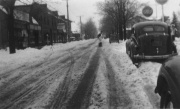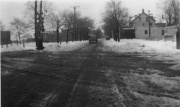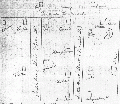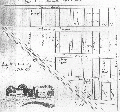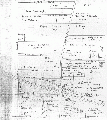Bethpage
From Central Park Historical Society Encyclopedia
From Settlement to the Early 20th Century
Thomas Powell, the man after whom our local Yorkers Club is named, was the original owner of what is today parts of Farmingdale, Bethpage, Old Bethpage, Plainview, Huntington and Plainedge. When the first settlers came to what today is Bethpage, the land was still owned by the Powells, who have been in the area since 1695.
The first man to settle the area was Rowland Pearsall, who bought his farmland from a Powell. He lived near where Plainview Rd. intersects with Cherry Ave. from about 1748 until his death. The farm was in his family until the mid-1850's.
Plainview Rd, from Haypath Rd. to Central Ave., was the first section of the town to be built up. In addition to the Pearsalls, there were the Bedells, Whitsons, Powells and Stymuses.
While it was not certain when the Bedells came here, they were one of the larger families present when the federal census of 1790 was taken; at that time William was the head of the clan. The farm, just north of the Pearsalls was in the hands of the Bedells until the early 1900's, when Carles, the last member here, sold it to Osios Karp, who operated a pickle factory on it.
Nathaniel Whitson had his home just south of the Seaford-Oyster Bay Expressway's Plainview Rd. exit. He came here in the the late 1700's or early 1800's and his family moved out about 1828. While the Whitsons were not a very important family here, they are mentioned because an old-time name for the low area the expressway traverses there is given after them: Whitson's Hollow.
The Powells, on the other hand, were much more important family. The first one here was Thomas Powell IV (all the other Powells before him lived in Farmingdale or Old Bethpage), whose house was just south of Nat Whitson's, the farm, however stretched from about Powell to Cherry Aves., north and south, and from Grumman's, east and west. They came here in the mid 1700's, after Rowland and Pearsall did. By 1790. Powell had a family of eight and one slave (at that time Quakers did not as a rule, condemn all slavery, only that which embodied mistreatment of the slaves; the Powells were Quakers at this time)
Finally, there was Christopher Stymus, whose home was between Norcross and Central Aves. He was a fairly well-to-do man who lived in Gravesend, Brooklyn, when he bought his first parcel of land here, in 1763, from Tunis Van Cotts, who in turn, had bought it from a Powell.
The makeup of Bedeltown (as Bethpage was then known), remained basically unchanged for almost 100 years after its initial settlement. A Dunn family purchased land, where Campagne School is today, in 1850, and Joshua Hobbs, whose home is still standing at the intersection of Farmers and Stewart Ave., bought land there and in the mid-1820's, most likely from the Bedells. In 1836, John Jarvis, a Quaker from Melville, purchased the Western end of the Powell estate from John Powell, a son of Thomas IV and his principal heir. Jarvis' home was where the community park is today. These families were those present during Bethpage's first "land boom."
The author is not prepared to give an explanation for the Pre Civil War expansion that our community suddenly went through, but it did happen and it did have the understandable effect on the community. By 1859, there were a large number of new people settling the land that has previously been unused. The Pearsalls sold their home and moved away, and the farm was constantly changing hands from then on until its dissolution. A man named Gustavus Zipple, who had come from the West Indies, had a farm around where Anselmi's Restaurant was, and another Gustavus, Mr. Witte, bought land between Stymus' and John Powell's in Whitson's Hollow, near Manchester Lane. Albrecht Benkert, a German merchant, operated the first railroad station here and was a early merchant and Postmaster. Finally, in the northern part of town, Daniel Margot had a farm on what was Skellington Lane, and a man named Hodges had one that was operated in part by the Gerhards. There were others too Ash, Evans and Quigley-but none were important. Of the above mentioned people, all except Mr. Benkert were typical farmers. However, the Bethpage of that time also had another kind of landowner: the speculators who had the town' first post office designation given as "Central Park" in order to attract people.
The largest land dealers were Alexander McConochie, a merchant from Brooklyn, his son-in-law Jeremiah T. Waever, and Baltis M. Fowler.
McConochie first started buying land here in the early 1840's from local people, and other outside owners as well. It was not odd in those days to buy many large tracts of land, and McConochies did, as a matter of fact, he and the Weavers controlled a good deal of Central Park's land for over twenty years. At one time or another, they owned the land west of Stewart Ave, much of it opposite Stewart Ave. from that; and about half of the state park land in Bethpage. The tracing of the deeds and land transfers for the period is very hard, because, for legal and financial reasons, the land was sometimes sold four or five times within the family, which leads to confusion.
McConochie, like many well-to-do people, did not live here permanently. Rather, he lived in Brooklyn and used his mansion, now known as the Beau Sejour, in the summer. J.T. Weaver, while he never owned it, also lived in it, as McConochie probably let his daughter and her family live in it also. (J.T. Weaver was married to Adelia McConochie.)
The Story of Alexander McConochie does not have a fairy tale ending, however. Some time after he cleared his land in Central Park, by selling it to his wife, his daughter and some outsiders, he seems to have made some bad business deals, for it is recorded that on 12-19-1859, Alexander, and his partner, James D. McConochie, having been lent money and having been unable to repay it, had all the land held by Alexander delivered to James B. Beers for auction.
Baltis Fowler had a partnership with a man named Henry Franklin. While they did most of their land purchasing in the Hicksville area, Fowler was recorded as the owner of two homes here: one on Stewart just south of Central Ave., and the other on Central near Seaman. The last named home was originally owned by J.T. Weaver, and served as Central Park's first Post Office, with Weaver as Postmaster. Altogether, Fowler was small potatoes compared to Weaver and McConochie.
The growth of the town continued through the rest of the 19th century . By 1870,Gustav Wittle had moved out of Whitsons' Hollow, selling his farm to Peter Nibbe, who owned it until about 1920. Mr. Zipple also left, selling his farm to William Knowland; from him it eventually went to the Capron family, who owned it through the early 20th century. John Powell's estate, valued at $10,000 in 1870, was quite diminished; it was down to the section that today is within the state park. He had sold sections to John Jarvis and some others to his children. In 1860 his elder son Charles died and his estate, from Powell Ave. to the Junior High and Broadway to the expressway, was sold to a distant cousin, Thomas U. Powell. This man was born in the Powell homestead that today is apart of the Old Bethpage Village Restoration. He was a distinguished looking man, with keen eyes and long chin wishers.
Through this period there were but few people in town who did not farm to make their livings. From about 1855 onward we had a one-room school house, and there were teachers employed as such. The first was Elizabeth Hubbs, the wife of Joshua; after her came Mrs. Grey, a relation of the Stymuses, who taught until the 20th century. Carl Damn was an early blacksmith, Marcus Schelhammer made cigars (a "segar maker", as the 1880 census put it), Louis Klug working on the Long Island Railroad and Augustus Freitag, who lived in what today is the Knights of Columbus Hall, was a silver beater (made silver leaf by pounding lumps of silver into paper thin sheets).
- This page was last modified on 20 December 2013, at 16:57.
- This page has been accessed 13,115 times.
